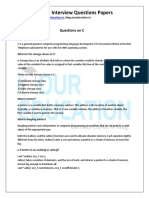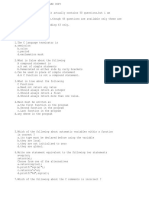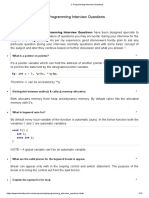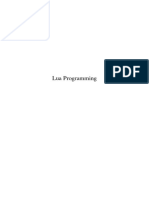OOPs Class Test - Answers
OOPs Class Test - Answers
Uploaded by
bhuvangatesCopyright:
Available Formats
OOPs Class Test - Answers
OOPs Class Test - Answers
Uploaded by
bhuvangatesOriginal Description:
Copyright
Available Formats
Share this document
Did you find this document useful?
Is this content inappropriate?
Copyright:
Available Formats
OOPs Class Test - Answers
OOPs Class Test - Answers
Uploaded by
bhuvangatesCopyright:
Available Formats
RAJALAKSHMI ENGINEERING COLLEGE
Thandalam, Chennai – 602 105
Department of Mechatronics Engineering
MT6604 - OBJECT ORIENTED PROGRAMMING IN C++
Class Test – I
Roll No. : Name :
Year : Branch: Section:
I. Fill in the blanks:
1. C++ is an object-oriented programming language.
2. C++ is a superset of C.
3. In C++ execution begins at main() function.
4. The C++ statements terminate with semicolons.
5. C++ introduces a new comment symbol // (double slash).
6. The identifier cout (pronounced as ‘C out’) is a predefined object that represents the
standard output stream in C++.
7. In C++, the standard output stream represents the screen.
8. The operator << is called the insertion or put to operator.
9. The header file iostream should be included at the beginning of all programs that use
input/output statements.
10. Namespace defines a scope for the identifiers that are used in a program.
11. In C++, main() returns an integer type value to the operating system.
12. The identifier cin (pronounced ‘C in’) is a predefined object in C++ that corresponds to the
standard input stream.
13. In C++, the standard input stream represents the screen.
14. The operator >> is known as extraction or get from operator.
15. The multiple use of << or >> in one statement is called cascading.
16. A typical C++ program would contain four sections.
17. The smallest individual units in a program are known as tokens.
18. Keywords are explicitly reserved identifiers and cannot be used as names for the program
variables or other user-defined program elements.
19. Identifiers refer to the names of variables, functions, arrays, classes, etc., created by the
programmer.
20. Constants refer to fixed values that do not change during the execution of a program.
21. In C++, all program processing can be coded by using only three logic structures.
22. The approach of using one or more of these basic control constructs in programming is
known as structured programming.
23. The do-while is an exit-controlled loop.
24. while is also a loop structure, but is an entry-controlled one.
25. The for is an entry-controlled loop and is used when an action is to be repeated for a
predetermined number of times.
2 B.BHUVANESWARAN | AP (SG) | CSE | Rajalakshmi Engineering College
II. Choose the best answer:
1. #include <iostream> is called
a) Preprocessor directive
b) Inclusion directive
c) File inclusion directive
d) None of the mentioned
Answer: a
2. The #include directive
a) Tells the preprocessor to grab the text of a file and place it directly into the current file
b) Statements are not typically placed at the top of a program
c) All of the mentioned
d) None of the mentioned
Answer: a
Explanation: The #include directive tells the preprocessor to grab the text of a file and place it
directly into the current file and are statements are typically placed at the top of a program.
3. If the file name is enclosed in double quotation marks
a) The preprocessor treats it as a user-defined file
b) The preprocessor treats it as a system-defined file
c) The preprocessor treats it as a user-defined file & system-defined file
d) None of the mentioned
Answer: a
4. If the file name is enclosed in angle brackets
a) The preprocessor treats it as a user-defined file
b) The preprocessor treats it as a system-defined file
c) The preprocessor treats it as a user-defined file & system-defined file
d) None of the mentioned
Answer: b
5. How many types of comments are there in C++?
a) 1
b) 2
c) 3
d) 4
Answer: b
Explanation: There are two types of comments. They are double slash and slash started.
B.BHUVANESWARAN | AP (SG) | CSE | Rajalakshmi Engineering College 3
6. What type of comments does C++ support?
a) single line
b) multiline
c) single line and multi-line
d) none of the mentioned
Answer: c
7. What is a comment in C++?
a) comments are parts of the source code disregarded by the compiler
b) comments are executed by the compiler to find the meaning of the comment
c) comments are executable
d) none of the mentioned
Answer: a
Explanation: Comments are used to add meaning to the program.
8. Comments in C++ starts with _______ symbol.
a) //
b) \\
c) **
d) None of the above
Answer: a
9. What is used to write multi line comment in C++?
a) /* …. */
b) /$ …. $/
c) //
d) none of the mentioned
Answer: a
Explanation: The /* is used to write the multi line comment.
10. Pick the odd one out:
a) array type
b) character type
c) boolean type
d) integer type
Answer: a
Explanation: Array type is not the basic type and it is constructed using the basic type.
11. Which data type is used to represent the absence of parameters?
a) int
b) short
c) void
d) float
4 B.BHUVANESWARAN | AP (SG) | CSE | Rajalakshmi Engineering College
Answer: c
Explanation: void will not return anything.
12. Which type is best suited to represent the logical values?
a) integer
b) Boolean
c) character
d) all of the mentioned
13. Which of the following is not one of the sizes of the floating point types?
a) short float
b) float
c) long double
d) double
Answer: b
Explanation: Logical values can be either true or false, so the boolean type is suited for it.
14. The size of an object or a type can be determined using which operator?
a) malloc
b) sizeof
c) malloc
d) calloc
Answer: b
Explanation: The sizeof operator gives the size of the object or type.
15. Which of the following will not return a value?
a) null
b) void
c) empty
d) free
Answer: b
16. Where does the execution of the program starts?
a) user-defined function
b) main function
c) void function
d) none of the mentioned
Answer: b
Explanation: Normally the execution of the program in C++ starts from main only.
B.BHUVANESWARAN | AP (SG) | CSE | Rajalakshmi Engineering College 5
17. How are many minimum numbers of functions need to be presented in C++?
a) 0
b) 1
c) 2
d) 3
Answer: b
Explanation: The main function is the mandatory part, it is needed for the execution of the
program to start.
18. All keywords in C++ are in
a) LowerCase
b) UpperCase letters
c) CamelCase letters
d) None
Answer: a
19. Which of the following is not a valid C++ variable name?
a) int number;
b) float rate;
c) int variable_count;
d) int $main;
Answer: d
Explanation: Since only underscore and no other special character is allowed in a variable
name, it results in an error.
20. Which of the following is true for variable names in C++?
a) They can contain alphanumeric characters as well as special characters
b) It is not an error to declare a variable to be one of the keywords (like goto, static)
c) Variable names cannot start with a digit
d) Variable can be of any length
Answer: c
Explanation: According to the syntax for C variable name, it cannot start with a digit.
21. Which is valid C++ expression?
a) int my_num = 100,000;
b) int my_num = 100000;
c) int my num = 1000;
d) int $my_num = 10000;
Answer: b
Explanation: Space, comma and $ cannot be used in a variable name.
6 B.BHUVANESWARAN | AP (SG) | CSE | Rajalakshmi Engineering College
22. Which of the following is not an arithmetic operation?
a) a *= 10;
b) a /= 10;
c) a != 10;
d) a %= 10;
Answer: c
23. Which of the following data type will throw an error on modulus operation (%)?
a) char
b) short
c) int
d) float
Answer: d
24. Which among the following is NOT a logical or relational operator?
a) !=
b) ==
c) ||
d) =
Answer: d
25. Which of the following are unary operators?
a) sizeof
b) –
c) ++
d) all of the mentioned
Answer: d
26. Associativity of an operator are:
a) Right to Left
b) Left to Right
c) Random fashion
d) Both Right to Left and Left to Right
Answer: d
27. Which of the following method are accepted for assignment?
a) 5 = a = b = c = d;
b) a = b = c = d = 5;
c) a = b = 5 = c = d;
d) None of the mentioned
Answer: b
B.BHUVANESWARAN | AP (SG) | CSE | Rajalakshmi Engineering College 7
28. Which of the following operators has the lowest precedence?
a) !=
b) &&
c) ?:
d) ,
Answer: d
29. Which operator is used for input stream?
a) >
b) >>
c) <
d) <<
Answer: b
Explanation: The operator of extraction is >> and it is used on the standard input stream.
30. The if...else statement can be replaced by which operator?
a) Bitwise operator
b) Conditional operator
c) Multiplicative operator
d) None of the mentioned
Answer: b
Explanation: In the conditional operator, it will predicate the output using the given condition.
31. The switch statement is also called as?
a) choosing structure
b) selective structure
c) certain structure
d) none of the mentioned
Answer: b
Explanation: The switch statement is used to choose the certain code to execute, So it is also
called as selective structure.
32. What is this operator called ?:?
a) conditional
b) relational
c) casting operator
d) none
Answer: a
Explanation: In this operator, if the condition is true means, it will return the first operator,
otherwise second operator.
8 B.BHUVANESWARAN | AP (SG) | CSE | Rajalakshmi Engineering College
33. Which of the following is a ternary operator?
a) &&
b) >>=
c) ?:
d) ->
Answer: c
34. Which operator works only with integer variables?
a) increment
b) decrement
c) both increment & decrement
d) none of the mentioned
Answer: c
35. Example of iteration in C++.
a) for
b) while
c) do-while
d) all of the mentioned
Answer: d
36. Which looping process is best used when the number of iterations is known?
a) for
b) while
c) do-while
d) all looping processes
Answer: a
37. Which loop is most suitable to first perform the operation and then test the condition?
a) for loop
b) while loop
c) do-while loop
d) none of the mentioned
Answer: c
38. The insertion operator is another name for _____.
a) input operator
b) output operator
c) extraction operator
d) None of the above
Answer: b
B.BHUVANESWARAN | AP (SG) | CSE | Rajalakshmi Engineering College 9
39. The extraction operator is another name for _____.
a) input operator
b) output operator
c) extraction operator
d) None of the above
Answer: a
40. When will the cin can start processing of input?
a) After pressing return key
b) By pressing blank space
c) After pressing return key & BY pressing blank space
d) None
Answer: a
ALL THE BEST
10 B.BHUVANESWARAN | AP (SG) | CSE | Rajalakshmi Engineering College
You might also like
- (M8S2-POWERPOINT) - Data Control Language (DCL)Document24 pages(M8S2-POWERPOINT) - Data Control Language (DCL)Yael CabralesNo ratings yet
- CS8391-Data Structures-Anna University Question PapersDocument8 pagesCS8391-Data Structures-Anna University Question Papersbhuvangates75% (4)
- Excel Formulas MLMDocument35 pagesExcel Formulas MLMAnand KiranNo ratings yet
- 440 Sample Questions DecDocument7 pages440 Sample Questions DecSai KumarNo ratings yet
- GS200 Final Exam 2017Document4 pagesGS200 Final Exam 2017Mohmed Al NajarNo ratings yet
- IT6601 MC AU QP Reg 2013Document11 pagesIT6601 MC AU QP Reg 2013bhuvangatesNo ratings yet
- Wipro Technical QuestionsDocument2 pagesWipro Technical QuestionsgopalNo ratings yet
- CSE1001 LO SJT121 VL2018191001852 Reference Material I Session 19Document6 pagesCSE1001 LO SJT121 VL2018191001852 Reference Material I Session 19ermiasNo ratings yet
- CS-100-QP2-Solved-KTU Notes PDFDocument44 pagesCS-100-QP2-Solved-KTU Notes PDFRekha V R100% (1)
- UST Global Interview Questions On CDocument6 pagesUST Global Interview Questions On CKeerthi VasanNo ratings yet
- Accenture Cracker by Pappu Career GuideDocument46 pagesAccenture Cracker by Pappu Career GuideSatNo ratings yet
- Wipro Interview Questions & Answers1Document5 pagesWipro Interview Questions & Answers1Dorothy Saikia100% (1)
- Tcs CDocument5 pagesTcs CtinaNo ratings yet
- Wipro Elite NLTH Coding Placement QuestionsDocument16 pagesWipro Elite NLTH Coding Placement QuestionsShivamNo ratings yet
- SampleDocument8 pagesSample030IT J.Priyadharshini0% (3)
- Software Metric: 19 QuestionsDocument38 pagesSoftware Metric: 19 QuestionsKhairol AzwanNo ratings yet
- Interview Question To Crack InterviewsDocument3 pagesInterview Question To Crack Interviewszynofus technologyNo ratings yet
- C Programming Interview QuestionsDocument13 pagesC Programming Interview QuestionsSHREENIVAS MNo ratings yet
- Practice Questions of Pointers and Strings: PointerDocument2 pagesPractice Questions of Pointers and Strings: PointerManishaNo ratings yet
- Data Structures Objective Questions and Answers - Set-3 - SearchcroneDocument10 pagesData Structures Objective Questions and Answers - Set-3 - SearchcroneSunny Raj0% (1)
- Final StringDocument121 pagesFinal StringDayanidhiDani100% (2)
- Zycus Infotech Aptitude Question PaperDocument5 pagesZycus Infotech Aptitude Question PaperJames Ronaldo67% (3)
- Mysql PracticalDocument8 pagesMysql PracticalShambhavamNo ratings yet
- Object Oriented Concepts: 18CS45 Model Question Paper-1 With Effect From 2019-20 (CBCS Scheme)Document2 pagesObject Oriented Concepts: 18CS45 Model Question Paper-1 With Effect From 2019-20 (CBCS Scheme)Vaishak kamathNo ratings yet
- SQL Notes Campus MonkDocument37 pagesSQL Notes Campus MonkImran ShaikhNo ratings yet
- 2005 Placement PapersDocument41 pages2005 Placement PapersP Venu Gopala RaoNo ratings yet
- C - Operators and ExpressionsDocument7 pagesC - Operators and ExpressionsBobbyNo ratings yet
- Java PracticalDocument50 pagesJava PracticalPal BhartiNo ratings yet
- Amcat AutomataDocument2 pagesAmcat AutomataRakesh ChadalavadaNo ratings yet
- 1) Aim: Demonstration of Preprocessing of Dataset Student - ArffDocument26 pages1) Aim: Demonstration of Preprocessing of Dataset Student - ArffKota Venkata JagadeeshNo ratings yet
- C Interview Questions PDF For FreshersDocument30 pagesC Interview Questions PDF For FreshersKappa yagnanandharaju100% (1)
- Cocubes Paper2Document4 pagesCocubes Paper2surekhaNo ratings yet
- Unit-4 DS StudentDocument43 pagesUnit-4 DS StudentHarpreet Singh BaggaNo ratings yet
- Aptitude Mock Test On CN, OS, DBMS On 18aug 21 P2P - 2022Document11 pagesAptitude Mock Test On CN, OS, DBMS On 18aug 21 P2P - 2022namNo ratings yet
- Computer Graphics Practical FileDocument30 pagesComputer Graphics Practical FileFotavo JugilanNo ratings yet
- Lab 2 - Function and ArrayDocument4 pagesLab 2 - Function and Arrayananyasri.upadhyaNo ratings yet
- POP Using C - VTU Lab Program-4Document5 pagesPOP Using C - VTU Lab Program-4vandana uNo ratings yet
- Relational Algebra NewDocument42 pagesRelational Algebra NewgurusodhiiNo ratings yet
- Function Overloading in C++Document15 pagesFunction Overloading in C++NandhiniNo ratings yet
- Bitwise Operators - 1Document5 pagesBitwise Operators - 1Govinda EkboteNo ratings yet
- Capegimini Aptitude MaterialsDocument4 pagesCapegimini Aptitude MaterialsSheik ShafiNo ratings yet
- Assignment 5 - Stacks and QueuesDocument22 pagesAssignment 5 - Stacks and QueuesTheAkHolicNo ratings yet
- TCS TECHNICAL MCQ'S (2020-21) : Programming LogicDocument51 pagesTCS TECHNICAL MCQ'S (2020-21) : Programming Logicnayomi cherukuriNo ratings yet
- CSE322 Formal Languages and Automation Theory 150+ MCQ QuestionsDocument70 pagesCSE322 Formal Languages and Automation Theory 150+ MCQ QuestionsKomaldeep SinghNo ratings yet
- C Program Lab ReportDocument30 pagesC Program Lab ReportNasim Bin Jasim50% (4)
- FALLSEM2018-19 CSE2001 TH SJT502 VL2018191005001 Reference Material I Unit-3lecture3Document7 pagesFALLSEM2018-19 CSE2001 TH SJT502 VL2018191005001 Reference Material I Unit-3lecture3Abhradeep Nag 16BEE0087No ratings yet
- MCA 312 Design&Analysis of Algorithm QuestionBankDocument7 pagesMCA 312 Design&Analysis of Algorithm QuestionBanknbprNo ratings yet
- C Programming UNIT 4.3 Structure and UnionDocument10 pagesC Programming UNIT 4.3 Structure and UnionrishikaNo ratings yet
- If, If..else Statement in Java With ExamplesDocument3 pagesIf, If..else Statement in Java With Examplesakhil100% (1)
- Database Design Schema RefinementDocument74 pagesDatabase Design Schema RefinementPurushothama ReddyNo ratings yet
- Faculty of Engineering: - Answer Any Four Full Questions Missing Data, If Any, May Be Assumed Suitably. 1. (A)Document2 pagesFaculty of Engineering: - Answer Any Four Full Questions Missing Data, If Any, May Be Assumed Suitably. 1. (A)aditiNo ratings yet
- C Programming For LoopDocument3 pagesC Programming For LoopslspaNo ratings yet
- Software Requirements Specifications: Submitted byDocument14 pagesSoftware Requirements Specifications: Submitted bySarang KhajuriaNo ratings yet
- C# Lab BCA III Sem-2Document13 pagesC# Lab BCA III Sem-2jobajo5825No ratings yet
- Cisc 630 - HW2 PDFDocument2 pagesCisc 630 - HW2 PDFUSVet96No ratings yet
- The Joy of Computing Using Python PART 1Document5 pagesThe Joy of Computing Using Python PART 1Rishi GuptaNo ratings yet
- Case Study - Cost Estimation With COCOMODocument2 pagesCase Study - Cost Estimation With COCOMOMaeeda Khalid0% (1)
- Relational AlgebraDocument13 pagesRelational AlgebraPooja DixitNo ratings yet
- Conditional Statements in C ProgrammingDocument11 pagesConditional Statements in C ProgrammingKalyanam ANo ratings yet
- Lab Report: Numerical AnalysisDocument67 pagesLab Report: Numerical Analysisali akbar100% (1)
- CS17302 OOP Class Test Unit I QDocument4 pagesCS17302 OOP Class Test Unit I QbhuvangatesNo ratings yet
- CDocument27 pagesCMagarsaaNo ratings yet
- MWA SyllabusDocument1 pageMWA SyllabusbhuvangatesNo ratings yet
- B.Bhuvaneswaran, AP (SG) / CSE, REC: 13 January 2022Document12 pagesB.Bhuvaneswaran, AP (SG) / CSE, REC: 13 January 2022bhuvangatesNo ratings yet
- Cloud Sim ManualDocument40 pagesCloud Sim ManualbhuvangatesNo ratings yet
- CS19611 MADL SyllabusDocument2 pagesCS19611 MADL SyllabusbhuvangatesNo ratings yet
- Cloudsim Toolkit - Course ContentsDocument1 pageCloudsim Toolkit - Course ContentsbhuvangatesNo ratings yet
- CB19442 DTDocument1 pageCB19442 DTbhuvangates0% (1)
- CB19541 AAD SyllabusDocument2 pagesCB19541 AAD SyllabusbhuvangatesNo ratings yet
- CB19511 IPL SyllabusDocument1 pageCB19511 IPL SyllabusbhuvangatesNo ratings yet
- CPP 04 PDFDocument1 pageCPP 04 PDFbhuvangatesNo ratings yet
- CB19742 IT Workshop (Scilab Matlab)Document2 pagesCB19742 IT Workshop (Scilab Matlab)bhuvangatesNo ratings yet
- CPP 05 PDFDocument1 pageCPP 05 PDFbhuvangates50% (2)
- CPP 02 PDFDocument1 pageCPP 02 PDFbhuvangates0% (1)
- CPP 03 PDFDocument1 pageCPP 03 PDFbhuvangatesNo ratings yet
- 01 Python IntroductionDocument13 pages01 Python IntroductionbhuvangatesNo ratings yet
- CB19241-CSBS-Data Structure and Algorithms-Theory-SyllabusDocument4 pagesCB19241-CSBS-Data Structure and Algorithms-Theory-SyllabusbhuvangatesNo ratings yet
- CPP 01 PDFDocument1 pageCPP 01 PDFbhuvangatesNo ratings yet
- CS17302 OOP Class Test Unit I QDocument4 pagesCS17302 OOP Class Test Unit I QbhuvangatesNo ratings yet
- CB19241-CSBS-Data Structures and Algorithms-Lab SyllabusDocument3 pagesCB19241-CSBS-Data Structures and Algorithms-Lab SyllabusbhuvangatesNo ratings yet
- CB19241-Data Structures and Algorithms-SyllabusDocument1 pageCB19241-Data Structures and Algorithms-SyllabusbhuvangatesNo ratings yet
- C MCQDocument42 pagesC MCQbhuvangates0% (1)
- C Basics Crossword PuzzleDocument2 pagesC Basics Crossword PuzzlebhuvangatesNo ratings yet
- Problem Solving and Python Programming Assignment - IIIDocument8 pagesProblem Solving and Python Programming Assignment - IIIbhuvangatesNo ratings yet
- Anna University - Dec - 2018 - Time TableDocument57 pagesAnna University - Dec - 2018 - Time TablebhuvangatesNo ratings yet
- Thingspeak IoTDocument7 pagesThingspeak IoTbhuvangatesNo ratings yet
- CS6202 - PDS - I - Unit Test - I - Important Questions - Part - ADocument8 pagesCS6202 - PDS - I - Unit Test - I - Important Questions - Part - AbhuvangatesNo ratings yet
- CSS Important MCQ QuestionsDocument16 pagesCSS Important MCQ Questionsbhuvangates100% (2)
- Stack ADTDocument36 pagesStack ADTbhuvangatesNo ratings yet
- Top 80+ JavaScript Interview Questions (Ultimate List)Document49 pagesTop 80+ JavaScript Interview Questions (Ultimate List)emilsinclair7.98No ratings yet
- CDocument161 pagesCMano HaranNo ratings yet
- FSOFT Student Test C.C++Document11 pagesFSOFT Student Test C.C++tuyenNo ratings yet
- Objective:: Explain How To Take Input A Single Character and Display It, Also Displaying StringDocument3 pagesObjective:: Explain How To Take Input A Single Character and Display It, Also Displaying Stringjames peterNo ratings yet
- OOPJ Practical ListDocument13 pagesOOPJ Practical Listsachin kohliNo ratings yet
- CS322 - Object Oriented Programming Concepts With Java - UG - 1st Sem-Dec-2022Document4 pagesCS322 - Object Oriented Programming Concepts With Java - UG - 1st Sem-Dec-2022thambi vargheeseNo ratings yet
- CSC 102 VB - Net, Data Types, Variables, Operators-2Document13 pagesCSC 102 VB - Net, Data Types, Variables, Operators-2favourchike001No ratings yet
- Computer Science Chapter 5 Constructors and Destructors From Sumita AroraDocument22 pagesComputer Science Chapter 5 Constructors and Destructors From Sumita AroraKamal Joshi78% (9)
- Test Items List Tuple and SetDocument5 pagesTest Items List Tuple and SetJeniffer MakalintalNo ratings yet
- Java Exception HandlingDocument14 pagesJava Exception HandlingDr Narayana Swamy RamaiahNo ratings yet
- Basic C MCQ - FinalDocument51 pagesBasic C MCQ - FinalDhivya DharshniNo ratings yet
- Unit 4 L8 Minimization of Boolean Functionskarnaugh MapDocument17 pagesUnit 4 L8 Minimization of Boolean Functionskarnaugh MapNiteesh KumarNo ratings yet
- Programming Microcontrollers in C PDFDocument26 pagesProgramming Microcontrollers in C PDFThành TrườngNo ratings yet
- C Multiple Choice Questions and Answers PDFDocument22 pagesC Multiple Choice Questions and Answers PDFUmesh Krishna100% (4)
- Coding in RPG IV - A Beginner's TutorialDocument18 pagesCoding in RPG IV - A Beginner's TutorialLFNNo ratings yet
- Lecture 4 - C Conditional Statement - IF - IF Else and Nested IF Else With ExampleDocument65 pagesLecture 4 - C Conditional Statement - IF - IF Else and Nested IF Else With ExampleMab AbdulNo ratings yet
- oops-with-java-bcs306a-model-paper-solutionDocument41 pagesoops-with-java-bcs306a-model-paper-solutionN M ShishirNo ratings yet
- Constructors: Presented By: Er. Simarpreet Kaur Subject: Programming in C++Document23 pagesConstructors: Presented By: Er. Simarpreet Kaur Subject: Programming in C++Peace ReminderNo ratings yet
- Python Tutorial-2Document3 pagesPython Tutorial-2Sumit TripathiNo ratings yet
- AcknowledgementDocument33 pagesAcknowledgementNishant NairNo ratings yet
- Notes Module2Document130 pagesNotes Module2T RNo ratings yet
- Bca Lab ProgramDocument2 pagesBca Lab ProgramSamuel VictorNo ratings yet
- 41 2nd PUC Comp Science SV Exam-1-1Document8 pages41 2nd PUC Comp Science SV Exam-1-1dhanushgowda2024No ratings yet
- WWW - Manaresults.Co - In: Code: 15A05403Document2 pagesWWW - Manaresults.Co - In: Code: 15A05403hkgjkhjhkNo ratings yet
- Lua ProgrammingDocument38 pagesLua ProgrammingPaul EduardNo ratings yet
- Canopen Documentation: Release 1.2.2.dev41+gff8b5caDocument58 pagesCanopen Documentation: Release 1.2.2.dev41+gff8b5caKarthik KichuNo ratings yet
- Conversions Question 1Document13 pagesConversions Question 1rahul rastogiNo ratings yet
- Array List in JavaDocument5 pagesArray List in JavaPriyansh GuptaNo ratings yet



















































































































